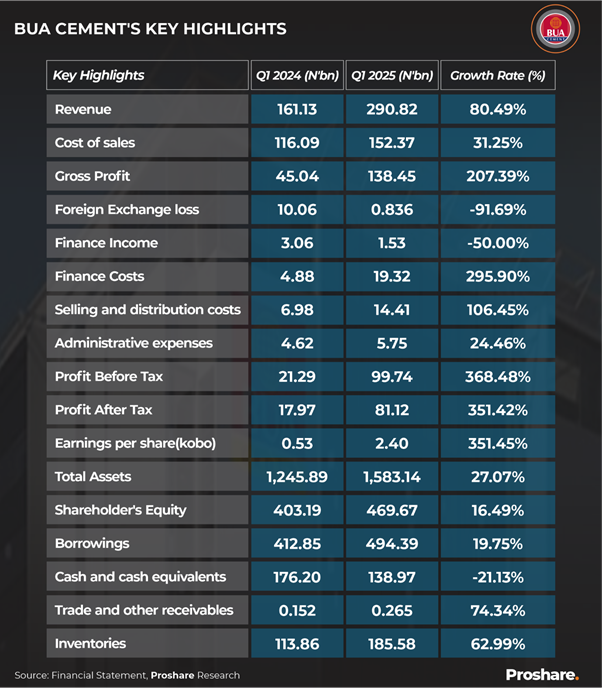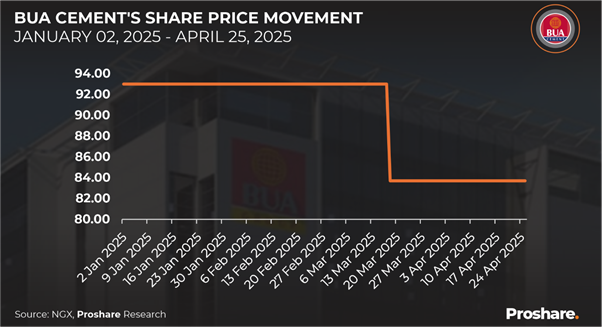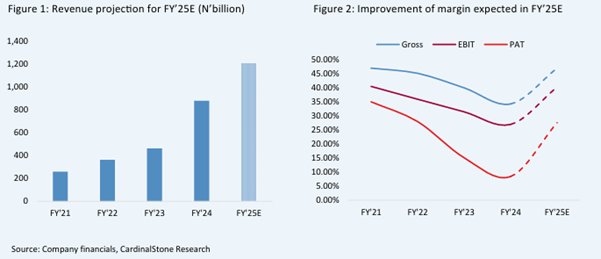BUA Cement Q1 2025 Report: Fall in FX Loss Drives Triple-Digit Profit Growth

Key Highlights
Price effect and renewed government commitment to infrastructural projects has supported the Nigerian
cement industry in the first quarter (Q1) 2025. The demand for cement remains and higher have driven top-line earnings to cushion the FX exposure and domestic inflationary pressures. The naira’s marginal appreciation and stability in Q1 2025 with an average of N1,521.78/US$1 compared to N1,621.71/US$1 average in Q4 2024 lowered FX revaluation losses, giving room for higher profitability growth. This narrative showed up in BUA Cement Q1 2025 financial numbers. The company’s top-line earnings rose by +80.49% to N290.82bn in Q1 2025 from N161.13bn in Q1 2024, followed by higher profit margins due to lower cost of sales growth (+31.25%) and a significant drop (-91.69%) in FX loss.
Despite, the clinker maker’s increased principal and interest repayment which raised the finance costs by +295.90% to N19.32bn in Q1 2025, with selling & distribution costs and administrative expenses rising by 106.45% and 24.26% to N19.32bn and N14.41bn in Q1 2025, respectively, the profitability grew by triple digits to N99.74bn (PBT) and N81.12bn (PAT). However, the cash position saw a marginal squeeze to N138.97bn in Q1 2025 as net cash flow from core operations dropped to N130.70bn, decommissioning liabilities adjustment and other CAPEX-related deductions. Nevertheless, the group’s strict cash and cash basis sales structure kept trade receivables below N300m compared to payables worth N382.36bn in Q1 2025, sustaining robust liquidity (see table 1 below).

Ratios
Cement’s financial ratios showed a positive profitability margin, return on equity and assets were strong but liquidity metrics slightly squeezed with current ratio and acid-test ratio lower than 1.00x. The group’s increased borrowings raised debt-to-equity ratio to 1.05x in Q1 2025 from 1.02x in Q1 2024 (see table 2 below).
Table 1:

Valuation
BUA Cement’s share price was flat for most of Q1 and then dropped before reverting to another flat trend. The company’s fundamentals were modestly strong, but it saw a lower trailing price-to-earnings ratio and price-to-book ratio (P/B) in Q1 2025. The P/E and P/B dropped to 34.94x and 6.03x, respectively (see table 3 below).
Table 3:

Share Price Movement
BUA Cement’s share price took a flat position at N93.00k from January 02, 2025 to March 17, 2025, reflecting a similar trend seen in Q4 2025. The share price saw a sharp drop to N83.70k on March 18, 2025, post announcement of the N2.05k dividend for FY 2024 and remained spread-out flat to April 28, 2025, to generate a negative return on -10.00% (see chart 1 below).
Chart 1:

Concluding Thoughts
BUA Cement showed resilience with its Q1 2025 financial performance, with higher earnings, a stronger balance sheet, and robust liquidity. The top-line earnings growth may persist in the other quarters of 2025 as demand for cement remains strong on the back of government infrastructural projects, anticipated N1 trillion FG housing funds and MOFI Real Estate Investment Fund. The expected low energy and logistics costs spurred by declining oil prices should cushion BUA Cement’s cost of sales and ensure profit growth, but the recent increase in naira volatility and depreciation pose a mild risk. Investment
BUA Cement: Stellar Q1 2025 Earnings Prompt Upward Review
BUA Cement Plc delivered an exceptional Q1 2025, which showed a considerable improvement in margins, prompting a revision in estimates and valuation. Our 12-month Target Price (TP) is revised upwards to N73.82, implying an 11.8% downside to our reference price.
Expected Improvement in Margins
As expected, BUACEMENT delivered a strong start to the year, with earnings per share (EPS) settling at N2.40, already surpassing the full-year 2024 EPS of N2.18. The impressive 351.4% YoY growth in earnings was supported by solid revenue performance, improved cost efficiency, and a sharp reduction in FX losses, resulting in margin expansion across the board. However, Q1 2025 revenue came in slightly below expectations, leading us to revise our FY 2025 revenue forecast downward to N1.2trn (from N1.3trn previously). While we maintain our average revenue per tonne assumption at N131,395, reflecting our updated view on industry-wide pricing dynamics, we have adjusted our volume projection to 9.1MMt, down from 10.0MMt.
BUACEMENT’s Q1 2025 margin performance underscores its strengthening cost discipline. Although energy and material costs rose moderately, partly due to the high-cost base from FY’24, our downward revision of volume expectations and cost discipline prompted a reassessment of operating assumptions. Consequently, we have lowered our FY’25 cost of sales estimate to N634.8 billion (from N861.4 billion) and operating expenses to N82.5 billion (from N97.2 billion). These revisions support a stronger margin outlook, with gross margin now projected at 47.0% (vs. 34.5% previously) and EBIT margin at 40.2% (vs. 27.3% previously).
We also highlight upcoming financial obligations in FY 2025, including the maturity of the First Bank Loan 2 with a carrying value of N4.6bn due in April 2025, alongside a principal repayment of N28bn under the company’s N115bn semi-annual coupon bond programme. These obligations are expected to reduce the company’s interest-bearing liabilities by year-end, supported by robust operating cash flows, especially as no additional borrowings were incurred during the review period. Nevertheless, we do not rule out the possibility of further external financing should the need arise.
Notably, the FX volatility that significantly impacted BUACEMENT’s performance in FY 2024 eased considerably in Q1 2025. The company reported a markedly lower FX loss of N836.8m, compared to N10.1bn in Q1 2024, highlighting the positive impact of naira stability during the period. Considering this, we have revised our FX loss assumptions downward, resulting in a higher projected PBT margin of 35.4% for FY’25E (previously 20.5%) and a PAT margin of 27.6% (vs. 15.2% previously). Consequently, we now expect EPS to print at N9.76, representing a 333.2% YoY increase.

Valuation
Following adjustments to our model, we revise our 12-month target price to N73.82 (from N66.17 previously). Although stronger earnings have brought the stock price closer to fundamentals, we maintain our SELL recommendation, as the target price implies an 11.8% downside from the current price of N83.70. BUACEMENT continues to trade at a premium to Middle East and African peers—on both P/E (20.5x vs. 14.2x) and EV/EBITDA (8.3x vs. 7.1x) multiples—though recent earnings momentum has helped narrow the valuation gap.




